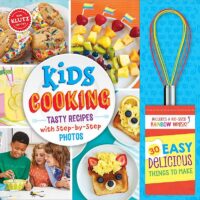Grow Your Own Rock Candy
Try this sweet science experiment from Kids Cooking.

Have a junior gemologist who loves rocks? Teach the science behind crystal formation with a sweet twist by growing rock candy at home. It’s a science experiment your child can eat! Rock candy takes a few weeks to grow, so make sure your child plans ahead.
Recipe:
Rock Candy Lab from Kids Cooking
Prep time: 15 minutes
Wait time: 2-3 weeks
You will need:
- ½ cup water
- 1 cup sugar
- Food coloring (optional)
- Tall glass jar
- Saucepan
- Whisk
- Cotton String
- Chopstick or popsicle stick
- Scissors
Instructions:
1. Have your child cut a piece of string 2 or 3 times the height of your jar. Tie one end of the string to the chopstick. *TIP: Cut 3 pieces of string and braid them together to make bigger rock candy crystals. Set aside.
2. PARENTS DO THIS STEP! Put the water into the saucepan and bring it to a boil on the stove.
3. PARENTS DO THIS STEP! Turn off the heat and immediately add sugar to the saucepan. Whisk for 2 minutes until the sugar is dissolved. The liquid should be clear, but if you’d like, you can add a drop of food coloring now.
4. PARENTS DO THIS STEP! Carefully pour the mixture into the tall jar.
5. Ask your child to dip the string into cold water and roll it in loose sugar to “seed” the crystals.
6. Then, have your child lay the chopstick across the mouth of the jar with the string dipped inside. The dangling end can coil around the bottom of the jar.
7. Have your child leave the jar on the counter for 2–3 weeks to let the candy crystals grow. Your child can lift the string out of the jar every few days to check on it, but make sure to put it back in the sugar mixture. When your child is happy with the number of crystals that have grown on the string, remove it, and hang it up to dry.
8. Enjoy!
How it works (the science part)
Two things are required to grow crystals: seed crystals and a saturated solution. The sugar granules your child rolled on the string are the seed crystals. The sugar water your child poured into the jar is a saturated solution. (This just means that if your child added any more sugar to the water, it can’t dissolve.) As the saturated solution cools and evaporates, crystals will grow on the seed crystals and get bigger and bigger to give your child rock candy!
Comes With:
Rainbow whisk
Decorative stickers
Books & Reading

Timeless Chapter Books Every Child Should Read
Introduce your child to beloved chapter books and series, and connect them to generations of reading for pleasure.
6 Benefits of Rereading Books (Over...and Over) for Kids
Repeat reads of books — whether as read-alouds to little ones or through independent reading — generate big benefits for your child.
Books Parents Loved as Kids That Still Resonate Today
We surveyed our Facebook fans and Scholastic Parents staff to compile this list of children's book favorites.
See MoreSchool Success

The Guide to Kindergarten: Reading and Writing
Review reading and writing curricula for kindergarten, learn what to expect, and discover the books and activities you can use to support learning.
The Guide to 1st Grade: Reading and Writing
Review reading and writing curricula for first grade, including what to expect and the books and activities you can use to support learning.
The Guide to 2nd Grade: Reading and Writing
Review reading and writing curricula for second grade, learn what to expect, and discover the books and activities you can use to support learning.
See MoreFamily Life

7 Books About Giving Every Child Should Read
With rich illustrations and moving messages, this collection of books will show 4- to -10 year-olds the importance of giving and kindness.
Beautiful Books That Show Kids How to Be Grateful
Gratitude gives kids an entirely new outlook on life, and with the right books, teaching it comes naturally.
10 Books That Celebrate Reading
These titles will show your child how to read a book — and why it's such a magical experience.
See MoreActivities & Printables





